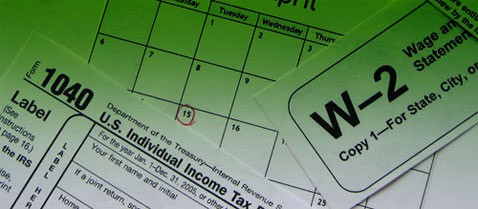The 2014 tax rates have been released for a couple of months now, but I haven’t gotten around to sharing them until now.
For most people the 2014 tax rates won’t really matter that much until early 2015 when they start thinking about filing their taxes, but if you’re a small business owner or a freelancer paying estimated tax payments throughout the year, knowing what the 2014 marginal tax rates will be could be helpful.
If you’re just starting to think about filing your 2013 taxes right now, you may want to check out the 2013 tax brackets.
For 2013 there was quite a bit of uncertainty when it came to the tax rates, there were a lot of changes that were rumored to be happening, but in the end the main change to the tax rates was that the 39.6 percent tax rate for higher income earners was re-instated after 35% was the highest rate for quite a while.
So now that 2014 has arrived, what changes can we expect to see in the 2014 marginal tax rates?
Quick Navigation
What Is A Marginal Tax Rate?
Before looking at what the rates will look like in 2014, one thing that is often misunderstood is just exactly what the marginal tax rates are. So what is a marginal tax rate?
Your marginal tax rate is the tax rate you pay on the last dollar of income. So if you’re a single filer and you earn $100,000 in the 2014 tax year, your marginal rate will be 28%.
Having a marginal tax rate of 28% doesn’t mean that you pay 28% of your income in taxes, however. Just that you pay 28% tax rate on the amount above the bracket limit. Your effective tax rate could be much lower.
2014 Federal Income Tax Rates
The marginal tax rates for 2014 are now completed, and you can find them in the table below.
| 2014 Tax Brackets | Single | Married Filing Jointly |
|---|---|---|
| 10% Bracket | $0–$9,075 | $0–$18,150 |
| 15% Bracket | $9,075 –$36,900 | $18,150–$73,800 |
| 25% Bracket | $36,900–$89,350 | $73,800–$148,850 |
| 28% Bracket | $89,350–$186,350 | $148,850–$226,850 |
| 33% Bracket | $186,350–$405,100 | $226,850–$405,100 |
| 35% Bracket | $405,100–$406,750 | $405,100–$457,600 |
| 39.6% Bracket | $406,750+ | $457,600+ |
By way of comparison, here is the 2013 tax brackets.
| 2013 Tax Brackets | Single | Married Filing Jointly |
|---|---|---|
| 10% Bracket | $0–$8,925 | $0–$17,850 |
| 15% Bracket | $8,926 –$36,250 | $17,850–$72,500 |
| 25% Bracket | $36,250–$87,850 | $72,500–$146,400 |
| 28% Bracket | $87,850–$183,250 | $146,400–$223,050 |
| 33% Bracket | $183,250–$398,350 | $223,050–$398,350 |
| 35% Bracket | $398,350–$400,000 | $398,350–$450,000 |
| 39.6% Bracket | $400,000+ | $450,000+ |
As you can see, the changes mainly are small bumps in the marginal tax rates due to the rate of inflation that the IRS announced it would use back in September of 2013.
There aren’t any major changes like there were last year, when the 39.6% tax bracket was added back in.
Updated Standard Deductions & Personal Exemption
Inflation not only has an affect on the tax brackets, but also on the standard deduction and personal exemption amounts.
| 2014 | Single | Married Filing Jointly | Head of Household |
|---|---|---|---|
| Standard Deduction | $6,200 | $12,400 | $9,100 |
| Personal Exemption | $3,950 |
The standard deduction for single filers has gone up for 2014 to $6,200, an increase of $100.
The standard deduction for married filing jointly taxpayers in 2014 has gone to $12,400, a bump of $200.
In 2014 the personal exemption will be $3,950.
What Is Your Effective Tax Rate?
So we already know that your marginal tax rate is determined by your last dollar of income. Your effective tax rate is the rate you actually pay based on the brackets.
For example, let’s say you’re a single filer with $100,000 of income, in the 28% tax bracket. If you have a simple tax situation you would then figure out your effective tax rate by doing the following:
- $100,000 gross income minus $6,200 (standard deduction) = $93,800
- $93,800 minus $3,950 (personal exemption) = $89,850 taxable income
So now after exemptions and standard deductions for a single filer, we have $89,850 of taxable income that we can use when looking at the tax rate schedules.
So we would then see the following taxes on the $89,850 of taxable income (assuming no other deductions):
- 10% tax of $907.50 tax on the first $9,075.
- 15% tax of $4,173.75 on the next $27,825. (Running total of $5,081.25)
- 25% tax of on the next $52,450. (Running total of $18,193.75)
- 28% tax of $140 on the last $500. (Running total of $18,333.75)
So on a total gross income of $100,000, after the standard deduction and personal exemption, a person would have a taxable income of $89,850. On that income they would pay $18,333.75 in taxes.
So effectively this hypothetical person would be paying 18.33% in taxes, despite being in the 28% tax bracket.
Have questions or comments about the marginal tax rates for 2014? Share your thoughts in the comments!



Thanks for explaining this. Taxes are confusing enough already. I will refer to this to see my effective tax rate.